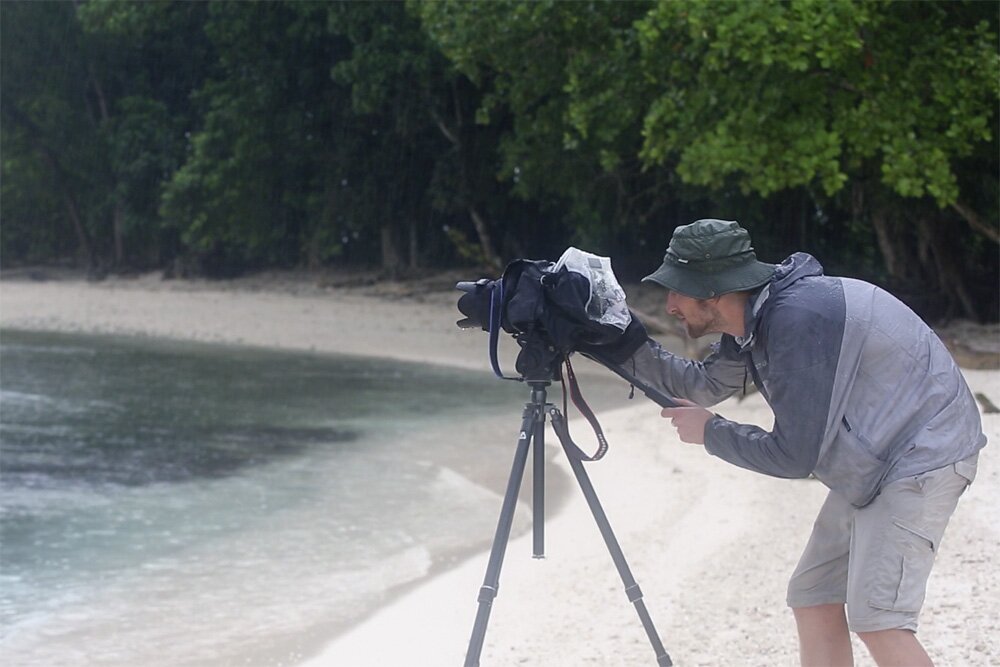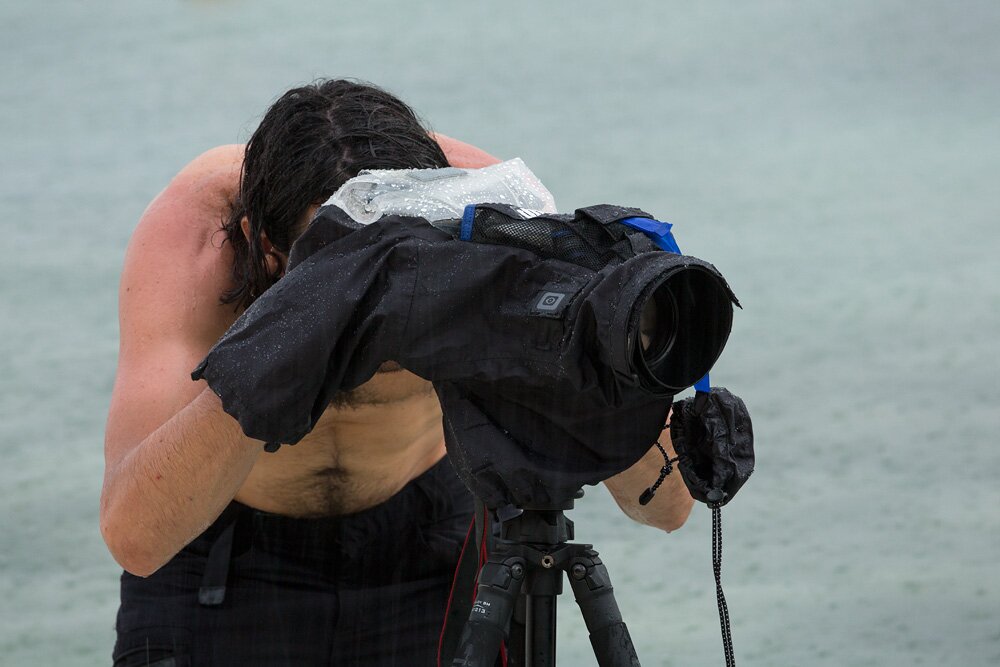Day’s Edge Productions just returned from a 2-week filming expedition in the Solomon Islands with Dr. Al Uy of the University of Miami. Knowing that it was the rainy season, and not wanting the rain to cramp our style, we asked Think Tank if they would give us two Hydrophobia® camera rain covers to use on location. They kindly agreed and, as expected, the Solomon Islands gave us plenty of chances to put the Hydrophobias through their paces!
First, what does this rain cover do? Basically, the Think Tank Hydrophobia allows you to operate your DSLR camera in the rain without having to worry about your camera or lens getting wet. It consists of a well-fitted waterproof fabric cover with holes in just the right places for your hands and the front of the camera lens. It’s also got a nice internal attachment loop that goes around the base of the lens and allows you to carry the whole setup by an external strap (rather than using your own camera strap, which is inside the cover). Both Nate and I got the Hydrophobia® Flash 70-200, which has an additional transparent flash cover that allows you to use a large professional flash, like the Canon 580EX flashes that we use most often, attached to the camera’s hot shoe.
Here’s what we liked, based on our use of the Hydrophobia covers in the Solomon Islands:
1) The Hydrophobias did their job, and did it well. We were never worried that our cameras were getting wet, even in the heaviest downpour that we encountered. The waterproof material is sturdy and the seams look like they’ll last a long time. These things look and feel durable, and we expect them to wear well.
2) The openings in the rain cover are well positioned to allow you to manipulate the camera controls — right hand for most of the shooting controls on the Canon 5D Mark II or 5D Mark III, and the left hand for focusing, zooming, and operating miscellaneous controls on the left side of the camera body. There’s enough room to move your hands around inside the cover, but not so much extra room that it feels baggy. The bottom / left hand opening also allows you to mount the camera to a tripod or monopod with the cover attached, which we did while shooting video in the rain.

Neil shooting video in the rain on Frigatebird Island with the Hydrophobia 70-200 Flash on his Canon 5D Mark III and 70-200mm lens.
3) This thing is really well thought out! There are lots of little details that make the Hydrophobia more functional, which we’ve come to expect from Think Tank. There’s a waterproof lens cap that you can quickly slip over the front of your lens hood when you’re done shooting. There’s a transparent flap, secured with Velcro, that you can use to cover the viewfinder when you’re not shooting (or when you’re shooting in Live View mode). The eyepieces (required for use; not included) are specific to each model of camera, and fit the cameras securely. The Hydrophobia mounts to these eyepieces very securely by means of a stretchy neoprene collar that grips the outer rim of the eyepiece. You can even keep an extra eyepiece in a little pocket on the outside of the Hydrophobia.
So overall the Hydrophobias are a pretty slick solution to a common problem: shooting in the rain. In a place like the Solomon Islands, particularly in the wet season, we couldn’t let rain limit our shooting options, and the Hydrophobias let us keep shooting in some pretty camera-unfriendly conditions, from downpours in the forest to rainy sea crossings from island to island in small, bouncing boats.

Nate using the Hydrophobia 70-200 Flash in heavy rain on the beach. The camera inside is a Canon 5D Mark III with an 80-200mm lens.
There were a few things that we found challenging when working with the Hydrophobias. First, as the name suggests, they really are made for 70-200mm lenses, and they’re best used with these larger lenses. We tried using the Hyrdrophobia with smaller lenses, and it can be done, particularly if the smaller lens has a decent-sized lens hood. The material covering the lens bunches up somewhat around shorter lenses, however — it was a bit tricky to access the focus and zoom rings of my 24-105mm f/4L lens with the Hydrophobia on. But it can be done, and having the option of using these smaller lenses definitely came in handy. Second, the Hydrophobia is at its best when you’re using the camera’s optical viewfinder. When shooting video (or stills with Live View enabled), the neoprene eyepiece collar and surrounding Velcro obscure the top edge of the LCD screen, so you won’t see 100% of the frame. That being said, we shot plenty of video with the Hydrophobia covers on, and we quickly learned to adapt. The clear plastic that covers the camera back can also get fogged up in very humid conditions, or with rapid temperature changes, but I was stupid and didn’t apply the (included) anti-fog coating to the plastic before the trip. I’m sure this would have solved the problem. Third, as someone with big hands, I found that there wasn’t quite enough room for me to reach in through the lower/left hole and adjust the zoom of the lens when the camera was attached to a tripod head like the Really Right Stuff BH-55 ballhead or Manfrotto 501 fluid head (a smaller tripod head, or smaller hands, would have been fine). Finally, if you’re not planning on using a flash very often, you’re probably better off with the non-flash version of the cover. The transparent flash “bubble” is a great feature, but stowing it away securely when you’re not using a flash isn’t trivial.
Conclusion: This is definitely a product we’ll be taking with us on our next trip to the Solomon Islands in June (with any luck, we can also try the Hydrophobia® 300-600 model to cover our supertelephoto needs when we’re shooting wildlife in the rain!). It’s a much more ergonomic and mobile solution for shooting in the rain than using an umbrella or rain jacket to cover your camera, both favorite strategies of ours in the past! We would recommend a Hydrophobia rain cover to anyone whose photographic work can’t wait for fair weather.

